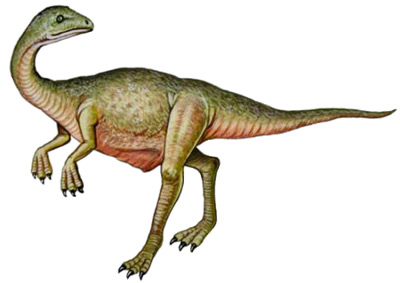
|
Search JoyZine with Google Site Search! |
Timimus
In 1991, two femora (thighbones), one from an adult and one from a juvenile, were found within a metre of each other at the Dinosaur Cove East site, in the small "Lake Copco" quarry, Victoria. The type species, Timimus hermani, was formally named and shortly described by Dr Thomas Rich and his wife Patricia Vickers-Rich in 1993/1994. The generic name means "Tim's Mimic" and combines the name of both the discoverers' son Timothy Rich and palaeontologist Tim Flannery with a Latin mimus, "mimic", a reference to the presumed affinity of the species with the Ornithomimosauria. The specific name honours volunteer John Herman who for many years assisted the Dinosaur Cove project. The holotype specimen, NMV P186303, was found in a layer of the Eumeralla Formation, dating to the Albian faunal stage in the early Cretaceous, some 106 million years ago. It consists of a left femur of an adult individual. The second femur, that of a juvenile, was assigned as the paratype, specimen NMV P186323. Some vertebrae from the site have been referred to the species, as well as some other South Australian material. The holotype thighbone is 44 centimetres long. From which a total length of the animal of 2.5m has been extrapolated. The slenderness of the bone suggest a lithe animal. The paratype femur is 19.5cm long. In 1994 Dr Rich commented that while it would have been more ideal to have had the most complete specimen possible as a holotype, it was highly unlikely that future material of Timimus would be found, due to the limited nature of sites to be explored in the area. Also, the holotype would have had characteristics which both identified it as an ornithomimosaur and a new genus within that group. In 1994 the describers assigned Timimus to the "Ornithomimosauridae" with which the Ornithomimidae were meant. Ornithomimosaur remains from Gondwana are rare and dubious; Timimus was thus presented as proof that the group was indeed present in the Southern Hemisphere and would even have originated there. Immediately however, a position within the Ornithomimosauria was doubted by Thomas Holtz. Today it is recognised that Timimus shares no derived traits with the Ornithomimosauria and that thus any proof it would belong to this group is lacking. It perhaps belongs to some coelurosaurian group; some workers consider it a nomen dubium. A 2012 study found it to be a valid tyrannosauroid. The habitat of Timimus consisted of polar forests with mild summers but cold and dark winters due to the closer proximity of the area to the South Pole during the Early Cretaceous. In 1996, Anusuya Chinsamy, an expert on the microstructure of fossil bones, examined bone material from Timimus and Leaellynasaura and discovered they exhibited different bone histology. The ornithischian showed a continuous rate of bone deposition, while the coelurosaur had a cyclical pattern of bone formation, which suggested Timimus may have hibernated in colder months. |
